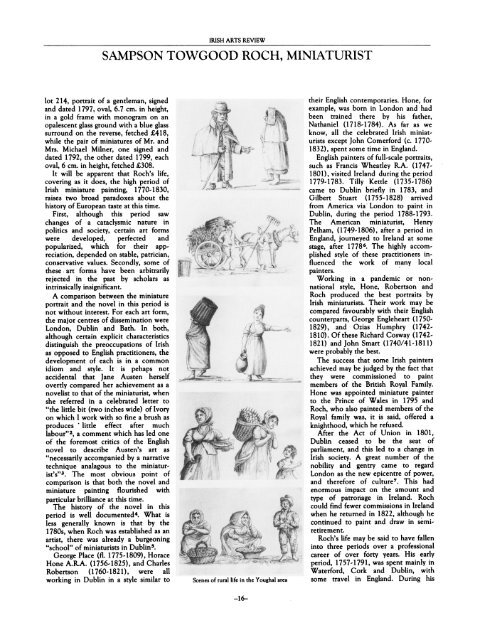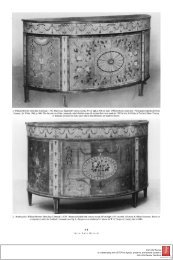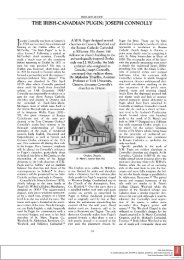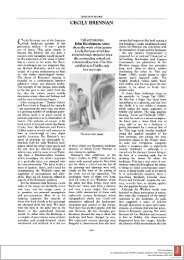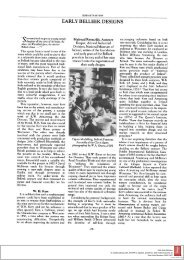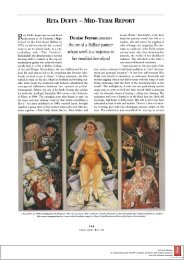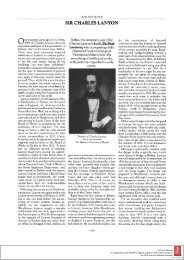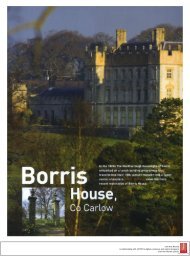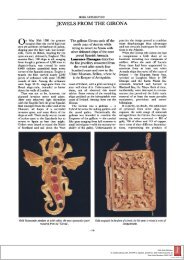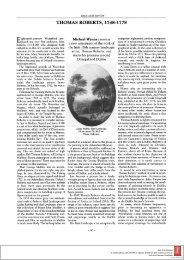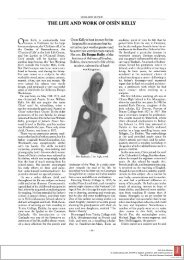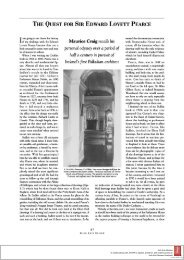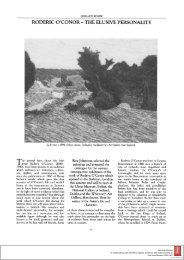SAMPSON TOWGOOD ROCH, MINIATURIST
SAMPSON TOWGOOD ROCH, MINIATURIST
SAMPSON TOWGOOD ROCH, MINIATURIST
You also want an ePaper? Increase the reach of your titles
YUMPU automatically turns print PDFs into web optimized ePapers that Google loves.
IRISH ARTS REVIEW<br />
<strong>SAMPSON</strong> <strong>TOWGOOD</strong> <strong>ROCH</strong>, <strong>MINIATURIST</strong><br />
lot 214, portrait of a gentleman, signed<br />
and dated 1797, oval, 6.7 cm. in height,<br />
in a gold frame with monogram on an<br />
opalescent glass ground with a blue glass<br />
surround on the reverse, fetched ?418,<br />
while the pair of miniatures of Mr. and<br />
Mrs. Michael Milner, one signed and<br />
dated 1792, the other dated 1799, each<br />
oval, 6 cm. in height, fetched ?308.<br />
It will be apparent that Roch's life,<br />
covering as it does, the high period of<br />
Irish miniature painting, 1770-1830,<br />
raises two broad paradoxes about the<br />
history of European taste at this time.<br />
First, although this period saw<br />
changes of a cataclysmic nature in<br />
politics and society, certain art forms<br />
were developed, perfected and<br />
popularized, which for their app<br />
reciation, depended on stable, patrician,<br />
conservative values. Secondly,<br />
some of<br />
these art forms have been arbitrarily<br />
rejected in the past by scholars as<br />
intrinsically insignificant.<br />
A comparison between the miniature<br />
portrait and the novel in this period is<br />
not without interest. For each art form,<br />
the major centres of dissemination were<br />
London, Dublin and Bath. In both,<br />
although certain explicit characteristics<br />
distinguish the preoccupations of Irish<br />
as opposed to English practitioners, the<br />
development of each is in a common<br />
idiom and style. It is pehaps not<br />
accidental that Jane Austen herself<br />
overtly compared her achievement as a<br />
novelist to that of the miniaturist, when<br />
she referred in a celebrated letter to<br />
"the little bit (two inches wide) of Ivory<br />
on which I work with so fine a brush as<br />
"<br />
produces little effect after much<br />
labour"2, a comment which has led one<br />
of the foremost critics of the English<br />
novel to describe Austen's art as<br />
"necessarily accompanied by<br />
a narrative<br />
technique analagous<br />
to the miniatur<br />
ist's"3. The most obvious point of<br />
comparison is that both the novel and<br />
miniature painting flourished with<br />
particular brilliance at this time.<br />
The history of the novel in this<br />
period is well documented4. What is<br />
less generally known is that by the<br />
1780s, when Roch was established as an<br />
artist, there was already a burgeoning<br />
"school" of miniaturists in Dublin5.<br />
George Place (fl. 1775-1809), Horace<br />
Hone A.R.A. (1756-1825), and Charles<br />
Robertson (1760-1821), were all<br />
working in Dublin in a style similar to Scenes of rural life in the Youghal<br />
area<br />
their English contemporaries. Hone, for<br />
example, was born in London and had<br />
been trained there by his father,<br />
Nathaniel (1718-1784). As far as we<br />
know, all the celebrated Irish miniat<br />
urists except John Comerford (c. 1770<br />
1832), spent some time in England.<br />
English painters of full-scale portraits,<br />
such as Francis Wheatley R.A. (1747<br />
1801), visited Ireland during the period<br />
1779-1783. Tilly Kettle (1735-1786)<br />
came to Dublin briefly in 1783, and<br />
Gilbert Stuart (1755-1828) arrived<br />
from America via London to paint in<br />
Dublin, during the period 1788-1793.<br />
The American miniaturist, Henry<br />
Pelham, (1749-1806), after a period in<br />
England, journeyed to Ireland at some<br />
stage, after 17786. The highly accom<br />
plished style of these practitioners in<br />
fluenced the work of many local<br />
painters.<br />
Working in a<br />
pandemic<br />
or non<br />
national style, Hone, Robertson and<br />
Roch produced the best portraits by<br />
Irish miniaturists. Their work may be<br />
compared favourably with their English<br />
counterparts, George Engleheart (1750<br />
1829), and Ozias Humphry (1742<br />
1810). Of these Richard Cosway (1742<br />
1821) and John Smart (1740/41-1811)<br />
were probably the best.<br />
The success that some Irish painters<br />
achieved may be judged by the fact that<br />
they were commissioned to paint<br />
members of the British Royal Family.<br />
Hone was appointed miniature painter<br />
to the Prince of Wales in 1795 and<br />
Roch, who also painted members of the<br />
Royal family was, it is said, offered a<br />
knighthood, which he refused.<br />
After the Act of Union in 1801,<br />
Dublin ceased to be the seat of<br />
parliament, and this led to a change in<br />
Irish society. A great number of the<br />
nobility and gentry came to regard<br />
London as the new epicentre of power,<br />
and therefore of culture7. This had<br />
enormous<br />
impact<br />
on the amount and<br />
type of patronage in Ireland. Roch<br />
could find fewer commissions in Ireland<br />
when he returned in 1822, although he<br />
continued to paint and draw in semi<br />
retirement.<br />
Roch's life may be said to have fallen<br />
into three periods<br />
over a professional<br />
career of over forty years. His early<br />
period, 1757-1791, was spent mainly in<br />
Waterford, Cork and Dublin, with<br />
some travel in England. During his<br />
-16


